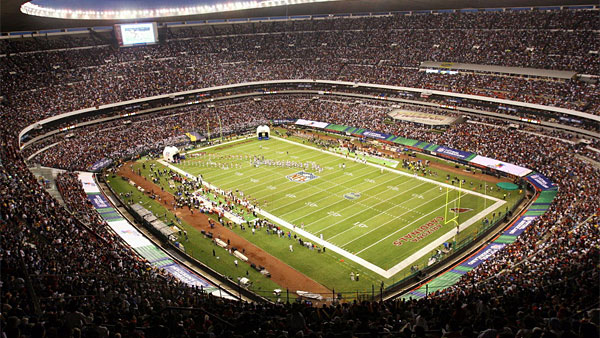
|  |  |  News Around the Republic of Mexico | August 2009 News Around the Republic of Mexico | August 2009  
In Mexico, a Soccer Stadium Where Visitors Gasp
 Jeré Longman - New York Times Jeré Longman - New York Times
go to original
August 11, 2009


| | Estadio Azteca de Mexico |  |
Mexico City — The massive bowl, Estadio Azteca, sits in the southern part of this sprawling metropolis like a concrete sombrero. The stadium’s mystique — especially its 105,000 spectators and its 7,200-foot altitude — will play an integral role Wednesday in a World Cup qualifying match between Mexico and the United States.

The Americans have never won a soccer match in Mexico. At Azteca, they are 0-18-1. Futility is not the sole province of the United States. In four decades, Mexico has lost only one World Cup qualifying match at Azteca — to Costa Rica in 2001.

Bob Bradley, the coach of the United States, will be making his first trip to Azteca. Only four current American players have played there: Landon Donovan, Oguchi Onyewu, Carlos Bocanegra and Steve Cherundolo.

Goalkeeper Tim Howard spoke of Azteca as a rite of passage. He said the ball traveled somewhat differently in thinner air. But he also noted that he and his teammates had played important games in front of large crowds, with the national team and with European club teams.

“Certainly, the atmosphere and the occasion is not going to be a hindrance to us,” Howard said Monday in a conference call from Miami.

Perhaps, but he has never been to Azteca, where visitors find oxygen harder to come by than victory.

Strange things seem to happen at Azteca, the only stadium to host two World Cup finals, in 1970 and 1986. This is where Diego Maradona’s infamous Hand of God goal occurred in a 1986 quarterfinal match between Argentina and England. More encouraging for the United States, it is also where the Americans escaped with a scoreless draw in 1997, despite playing a man down for nearly two-thirds of the match.

Azteca can be a dislocating place, Bruce Arena, the former American coach, said recently. He pointed to its steeply banked seats, its difficult sightlines and the distance of about 20 yards from the sideline to the team benches.

“It’s like you’re out in the country,” Arena said.

And yet, because the stands are removed from the field, visiting players do not have the claustrophobic sense that spectators are perched on top of them. In addition, the Americans are not as vulnerable to thrown coins and bags of urine, which sometimes greet them in Latin America.

“There’s no fear factor,” Donovan said in a recent interview. “It’s loud, intense; you can feel the passion. But if they try to throw things at us, they can’t reach us.”

A feeling of desperation attends this match from Mexico’s perspective. A defeat could cripple its chances of qualifying for the 2010 World Cup.

“We really need the fans,” defender Rafael Marquez said Monday at a news conference.

At this point, Mexico needs any edge it can get. Wednesday’s game has been shifted from night to midafternoon, to reduce chances of a downpour in the rainy season. And if the Americans struggle in moderate heat and heavy pollution, that’s acceptable gamesmanship.

“You can’t blame them,” Donovan said.

Altitude, of course, does not depend on time of day. It is an unavoidable, severe disadvantage for visiting teams in the North American, Central American and Caribbean region. The Americans sometimes use supplemental oxygen at halftime. The number and timing of substitutions become crucial.

“You start dealing with the heat and the altitude, and it gets into your head,” Arena said. “Not only your head — the physiology is difficult.”

At high altitude, many of the American strengths — counterattacking, running hard, playing a physical style — can be compromised by fatigue. This has been evident at Azteca, and, most recently, in the second half of the Confederations Cup final in Johannesburg, when the tired United States lost a 2-0 lead in a 3-2 defeat to Brazil.

“It doesn’t allow the U.S. to bring the kind of game they typically play to their opponent,” Arena said. “That’s the challenge. I think man for man, the U.S. is probably better, but the great equalizer is that altitude.”

Because of club commitments, the American players did not have 7 to 10 days of recommended time to acclimate to the altitude. So, on the advice of altitude experts, they will train in Miami for two days and arrive in Mexico City late Tuesday afternoon.

The advantage of arriving at altitude so near to a performance is not well established scientifically, experts said, but it is based on two factors.

One is the principle that recovery is more important for optimum performance than training is, said Dr. David Martin, an expert on elite performance at USA Track and Field. In other words, recovery should be easier from training in Miami than it would have been in Mexico City. Thus the Americans could decrease their chances of feeling flat Wednesday.

Two, by arriving at the last minute, the Americans hope to avoid a drop in blood plasma volume, which leads to dehydration of a sort that cannot be corrected simply by drinking more water, said Dr. Peter Hackett, the director of the Institute for Altitude Medicine in Telluride, Colo.

But there are disadvantages to arriving the night before you play, Hackett said. Players may get headaches and find it difficult to sleep, thus risking fatigue during the match.

“It’s clear the best thing is to be there and acclimatize,” Hackett said. “But they don’t have the time.” |

 |
|  |



